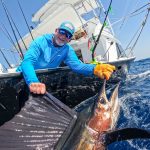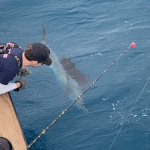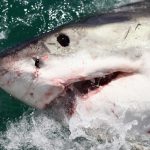
ROFFS™ Northeast U.S. Early Season Preview 2018 PROMISING FEATURES SHOULD LEAD TO A PRODUCTIVE SEASON
ROFFS™ concludes its 2018 spring preview series by providing an overall update of the oceanographic conditions from mid-to-late April offshore of the northeastern United States focusing in on the Mid-Atlantic Bight region and its canyons that includes the zone from Cape Hatteras to Georges Bank into the Gulf of Maine. We again utilized a combination of many different data sets mainly satellite derived sea surface temperature (SST) and ocean color/chlorophyll images. In this article we will discuss the present ocean conditions and what it means for the upcoming late-spring to summer fishing season for the North Carolina to Massachusetts area.
For forecasting short-term oceanographic conditions related to finding fish, ROFFS™ uses real-time direct observations. We have learned that evaluating the preseason conditions along with regional, downscaled climate models provides insight into future seasonal trends for fishing. Experience and understanding the ocean – atmospheric dynamics is our guide as we have had moderate success in forecasting seasonal trends of fishing productivity based on the stepwise progression in the location of the fishes’ preferred habitat based on temperature and water color. Please reference our 2018 Bahamas forecast for more in-depth discussion on the environmental and climate indicators that goes into our detailed evaluation of the eastern United States fishing forecasting analysis (Click Here).
Background and Some Observations for 2018
It is important to look at the year-to-year trends including the anomalies to gain insight into the location and condition of the fishes’ preferred habitat compared with previous years. Comparing similar locations and features to last year during the same mid-to-late April time period we found that the SST of the core of the Gulf Stream off of Cape Hatteras, NC for 2017 was approximately 78.0°F – 78.5°F and for this year it is 1.5°F to 2.0°F cooler (76.0°F – 77.0°F). The SST of the coastal water off of New Jersey, Delaware and Maryland is approximately 1.0°F cooler this year than during the same time period in 2017. Furthermore, the SST offshore of Long Island is also about 1.0°F cooler than this time last year. These and other indicators that will be described below suggest a slightly later arrival or a closer to normal arrival of the main migration of tuna, wahoo, dolphin and billfish into the northeast canyon region this year compared to last year.
One of the main reasons for the cool spring SST’s in the Northeast U.S. region can be attributed to the North Atlantic Oscillation (NAO) switching from a positive phase in February to an extreme negative phase in March. NAO index is based on the atmospheric surface sea level pressure difference between the Subtropical (Azores) High and the Subpolar Low within the North Atlantic Ocean (https://www.ncdc.noaa.gov/teleconnections/nao/). This extreme negative NAO index in March is likely responsible for the cooler than normal temperatures in the eastern United States and also associated with an increase of nor’easters and higher wind events in the Northeast U.S., which is exactly what we have been observing in this region this spring (http://view.surfline.com/eastcoastmarch/8/). Stay tuned or contact ROFFS™ for updated reports of the always-changing ocean conditions related to the best fishing action near your inlet.
The good news is the atmospheric temperatures are finally starting to warm and the SST will start to increase at a more rapid pace as April transitions into May. Also, please see ROFFS™ recent Southeast U.S. Gulf Stream fishing conditions analysis (Click here). These Gulf Stream conditions to the south are usually a good indicator and associated with an abundance of yellowfin tuna and marlin along with other highly migratory species. Recent reports the past two weeks have already confirmed a number of yellowfin tuna catches off of Oregon Inlet to Cape Hatteras, NC, where you find the Gulf Stream filaments and Gulf Stream edges. Based on historical observations we anticipate that these fish along with other tuna, dolphin, wahoo and then billfish will move to the northeast U.S. region from the Gulf Stream and into the relatively large eddy features that move over the canyon areas. Additional good news is that wahoo, dolphin, tuna and sailfish have already been caught off of South Carolina, North Carolina and northern Florida suggesting these species are already within the Gulf Stream and migrating north and soon (if not already) within the northeastern U.S. waters when the habitat is favorable.
 Please click HERE to read the full 2018 Northeastern U.S. Spring Season Preview on our website now!
**REMINDER** ROFFS™ CHANGE IN SUMMER HOURS AND SATURDAY ORDERING POLICY
PLEASE NOTE that we are currently open until 6:00 PM EDT Monday through Friday and starting this Saturday (May 5th) until 4 PM EDT. Also, note that we have CHANGED our summer hours for 2018 and we will be closing at 7:00 PM EDT Monday through Friday (beginning Monday, May 24, 2018) and at 4:00 PM EDT on Saturday (beginning this Saturday, May 5, 2018). We may close earlier on Saturday’s based on demand and we will also remain open later some days based on workload.
MOST IMPORTANTLY, please note that we have also CHANGED our ordering policy for Saturday analyses for Sunday fishing this year. Please order your Saturday analysis (for Sunday fishing) by FRIDAY close of business (7:00pm EDT). You can still call/email or web order (roffs.com) Saturday analyses after business hours on Friday and BEFORE we open on Saturday (9:00 AM EDT), but we will NOT be taking orders for new areas after 9:00 AM EDT Saturday morning. Please call the office (321.723.5759) or email the office (feedback@roffs.com) with any questions/concerns. Thank you!
Please click HERE to read the full 2018 Northeastern U.S. Spring Season Preview on our website now!
**REMINDER** ROFFS™ CHANGE IN SUMMER HOURS AND SATURDAY ORDERING POLICY
PLEASE NOTE that we are currently open until 6:00 PM EDT Monday through Friday and starting this Saturday (May 5th) until 4 PM EDT. Also, note that we have CHANGED our summer hours for 2018 and we will be closing at 7:00 PM EDT Monday through Friday (beginning Monday, May 24, 2018) and at 4:00 PM EDT on Saturday (beginning this Saturday, May 5, 2018). We may close earlier on Saturday’s based on demand and we will also remain open later some days based on workload.
MOST IMPORTANTLY, please note that we have also CHANGED our ordering policy for Saturday analyses for Sunday fishing this year. Please order your Saturday analysis (for Sunday fishing) by FRIDAY close of business (7:00pm EDT). You can still call/email or web order (roffs.com) Saturday analyses after business hours on Friday and BEFORE we open on Saturday (9:00 AM EDT), but we will NOT be taking orders for new areas after 9:00 AM EDT Saturday morning. Please call the office (321.723.5759) or email the office (feedback@roffs.com) with any questions/concerns. Thank you!
 Please click HERE to view our hours on our website now!
New/Updated Videos on ROFFS™.com – Click the “Hot News” Button on ROFFS™ Homepage
Whale Shark!
Please click HERE to view our hours on our website now!
New/Updated Videos on ROFFS™.com – Click the “Hot News” Button on ROFFS™ Homepage
Whale Shark!
 Unbelievable approach! Video Courtesy: Herman Junior | Facebook
Please click HERE to watch the video on our website now!
Cat Vs. Gator!
Unbelievable approach! Video Courtesy: Herman Junior | Facebook
Please click HERE to watch the video on our website now!
Cat Vs. Gator!
 Unbelievable! Video Courtesy: CLaW – Conservation Lenses & Wildlife | Facebook
Please click HERE to watch the video on our website now!
Sand Crabs!
Unbelievable! Video Courtesy: CLaW – Conservation Lenses & Wildlife | Facebook
Please click HERE to watch the video on our website now!
Sand Crabs!
 Pacific mole crabs, also known as sand crabs, make their living just under the surface of the sand, where they’re safe from breaking waves and hungry birds. Some very special physics help them dig with astonishing speed. Video Courtesy: Deep Look – PBS | Facebook
Please click HERE to watch the video on our website now!
Delivery by Drone!
Pacific mole crabs, also known as sand crabs, make their living just under the surface of the sand, where they’re safe from breaking waves and hungry birds. Some very special physics help them dig with astonishing speed. Video Courtesy: Deep Look – PBS | Facebook
Please click HERE to watch the video on our website now!
Delivery by Drone!
 Doctors in rural Rwanda are able to order blood and medical supplies by text message and then have them delivered by a drone. Video Courtesy: BBC | Facebook
Please click HERE to watch the video on our website now!
Camouflage!
Doctors in rural Rwanda are able to order blood and medical supplies by text message and then have them delivered by a drone. Video Courtesy: BBC | Facebook
Please click HERE to watch the video on our website now!
Camouflage!
 Each species has a camouflaging niche…this one has evolved to hide in a reef of grumpy old men. Video Courtesy: True Facts | Facebook
Please click HERE to watch the video on our website now!
Ocean Race Action!
Each species has a camouflaging niche…this one has evolved to hide in a reef of grumpy old men. Video Courtesy: True Facts | Facebook
Please click HERE to watch the video on our website now!
Ocean Race Action!
 Experience the power of the wind, waves and sheer speed of the Volvo Ocean Race. This RAW 100 gives you the perspective only the sailors really know: the raw power of the Southern Ocean. Video Courtesy: Red Bull Adventure | Facebook
Please click HERE to watch the video on our website now!
Surface!
Experience the power of the wind, waves and sheer speed of the Volvo Ocean Race. This RAW 100 gives you the perspective only the sailors really know: the raw power of the Southern Ocean. Video Courtesy: Red Bull Adventure | Facebook
Please click HERE to watch the video on our website now!
Surface!
 A British Royal Navy hunter-killer submarine breaches through a thick layer of ice during Arctic exercises with the U.S. Navy. Video Courtesy: ABC News | Facebook
Please click HERE to watch the video on our website now!
Updated Photos
A British Royal Navy hunter-killer submarine breaches through a thick layer of ice during Arctic exercises with the U.S. Navy. Video Courtesy: ABC News | Facebook
Please click HERE to watch the video on our website now!
Updated Photos
 ROFFS™ client Fishbehavin “Had a great day of fishing with my son! Topped it off with this wahoo!! It was caught using lures provided by JAW Lures and on info provided to me by ROFFS Roffer’s Ocean Fishing Forecasting Service, Inc.” Offshore of Port Canaveral, FL last weekend – great catch guys!!!
ROFFS™ client Fishbehavin “Had a great day of fishing with my son! Topped it off with this wahoo!! It was caught using lures provided by JAW Lures and on info provided to me by ROFFS Roffer’s Ocean Fishing Forecasting Service, Inc.” Offshore of Port Canaveral, FL last weekend – great catch guys!!!
 ROFFS™ Client Adam Ladnier (Fleur De Lis), First Mate Preston Savage and Second Mate Mike Basso. Awesome Tuna action this past weekend out of Grand Isle, LA.
Please click HERE to view recent 2018 photos on our website now!
ROFFS™ Client Adam Ladnier (Fleur De Lis), First Mate Preston Savage and Second Mate Mike Basso. Awesome Tuna action this past weekend out of Grand Isle, LA.
Please click HERE to view recent 2018 photos on our website now!
Backlash? Feedback?

As always, please send comments & feedback on Fishy Times newsletter content directly to us at feedback@roffs.com. If you do not want to wait for our next Fishy Times newsletter, please visit us in the meantime to get all your fishing news using the social media/web links below. Safe and successful fishing until next time!
]]>




